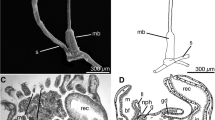Abstract
THE structure of the sensory endings of the vomero-nasal organ of vertebrates (Jacobson's organ) has been the subject of some controversy in past years1–3. Although the receptor cells seem to resemble closely those of the olfactory epithelium, the presence of cilia on their free ends is arguable. The problem has not yet been investigated by electron microscopy, and it is of interest to report the fine structure of these endings in a reptile, Anguis fragilis, where the vomero-nasal organ is particularly well developed.
Similar content being viewed by others
References
Allison, A. C., Biol. Revs., 28, 195 (1953).
Cordier, R., in The Cell, 6 (edit. by Brachet, J., and Mirsky, A. E.), 313 (Academic Press, New York, 1964).
Moulton, D. G., and Beidler, L. M., Physiol. Revs., 47, 1 (1967).
Brown, H. E., and Beidler, L. M., Fed. Proc., 25, No. 2 (1966).
Graziadei, P., and Bannister, L. H., Z. Zellforsch., 80, 220 (1967).
Bannister, L. H., Quart. J. Microsc. Sci., 106, 333 (1965).
Author information
Authors and Affiliations
Rights and permissions
About this article
Cite this article
BANNISTER, L. Fine Structure of the Sensory Endings in the Vomero-nasal Organ of the Slow-worm Anguis fragilis. Nature 217, 275–276 (1968). https://doi.org/10.1038/217275a0
Received:
Published:
Issue Date:
DOI: https://doi.org/10.1038/217275a0
- Springer Nature Limited
This article is cited by
-
Embryology of the VNO and associated structures in the grass snake Natrix natrix (Squamata: Natricinae): a 3D perspective
Frontiers in Zoology (2017)
-
The structure of the nasal chemosensory system in squamate reptiles. 2. Lubricatory capacity of the vomeronasal organ
Journal of Biosciences (2000)
-
Ultrastructural investigations on the nuchal organ of the protandric polychaete, Ophryotrocha puerilis (Polychaeta, Dorvilleidae)
Zoomorphology (1989)
-
Fine structure of the cerebral organs in hoplonemerteans (Nemertini), with a discussion of their function
Zoomorphology (1987)
-
Sensory structure of the tentacles of the slug, Arion ater (Pulmonata, Mollusca)
Cell and Tissue Research (1974)





